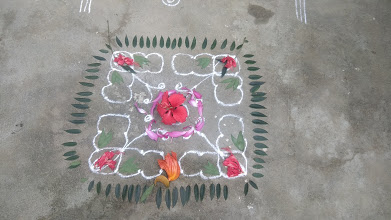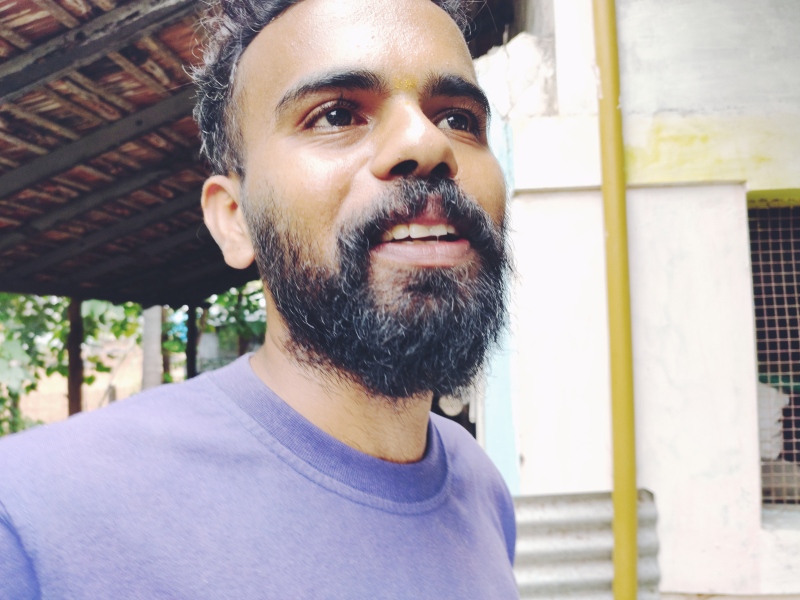A Course on Prema-culture

Sometimes we have the spark of an idea in our head, and one day, we stumble upon a fully developed version of that idea in a book. Such discoveries are delightful surprises. But they are more than that. They restore in us, faith in the integrity of the logical process of imagination. They give us hope that you and I can imagine our way to the same destination.
Now imagine if we were to discover a fuller version of your idea, not in a book but as a lived reality in a family and in a community they live in. It gives us much more than hope. It confirms and validates your idea as a real possibility and moves you in that direction with more faith and strength.
Such is the family of Duong Chau and Hang Mai.

When we heard that Chau and Hang Mai are visiting India to attend Gandhi 3.0, and they were willing to arrive 2 weeks earlier, Nisha jumped at the opportunity to invite them over to our farm. We arranged a one-week, residential, permaculture course offered as a gift to eighteen of our farmer friends and requested Chau and Hang to facilitate it. Three of our friends, including Dhamu, our star-volunteer, offered to volunteer for the course.
Before the course started, Chau told us that he is moving away from PowerPoint presentations and classroom theory sessions. He wanted to listen to the life stories and challenges of the course participants and respond to them by sharing relevant concepts and examples from life experiences because such contextual explorations are at once conceptually strong and highly practical.
We had been shaping our own educational efforts in the areas of Nature Cure, Homeschooling and Natural Farming in a similar direction. So we started the course without a predetermined outline but trusting the emergence.

We had a diverse group of back-to-the-land farmers whose mainstream profession covers a whole spectrum – from a Civil Engineer to an Ice Cream Retailer! Just to make it spicier, we also included a Tech Monk and a Flow Artist 🙂
The gifts started coming in even before the course started…Three of the participants worked for a week to create a professional-looking roof above the dining area from reclaimed material. And things just started showing up..a tent, few chairs, name tags, chemical-free soaps, papayas, red bananas, tomatoes, veggies, greens. healthy snacks, car pool arrangements, rolling beds, pillows and bed sheets for the winter, additional homes in the neighborhood opening up, steady supply of drinking water just to name a few.
And as soon as they arrived, Chau and Hang filled our dining table with sustainable gifts that they brought from Vietnam for the course. And they put themselves to work giving a hand with everything that was going on and even creating their own tasks to make things “better”.
And the gifts continued to flow throughout the course in the form of hands helping with everything from daily decor to plumbing. The first dinner was Aarti and Arabindh’s gift of artisanal bread made with just 3 ingredients. The yummy bread met its match in homemade ketchup from organic tomatoes prepared by two Moms with love and a vegetable stew cooked with love by volunteers.
On day one, Chau and Hang Mai guided the group to focus on all the “why” questions and carefully shielded the exploration from all the “what” and “how” questions that normally mushroom in a grounded subject like farming. In the middle of a discussion that veered towards “market reality”, Hang Mai jumped and rushed to the blackboard and furiously scribbled a quote from Masanobu Fukuoka that read:
“The ultimate goal of farming is not the growing of crops, but the cultivation and perfection of human beings.”
She knew it too well because she had helped translate The One-Straw Revolution into Vietnamese and had distributed thirty thousand copies so far around the country.
 In the afternoon, Chau drew on the board a picture of their farm and shared what they grow, why and how they live their daily life. It was super inspiring to learn that they live a self-sufficient life and their monetary expenses are less than $60 a month. In their two hectares farm, they have allocated only one acre for active cultivation for home-needs. And even within that one acre that has four ponds, one in each quadrant, they cultivate foods in a quarter-acre quadrant and rotate it every year.
In the afternoon, Chau drew on the board a picture of their farm and shared what they grow, why and how they live their daily life. It was super inspiring to learn that they live a self-sufficient life and their monetary expenses are less than $60 a month. In their two hectares farm, they have allocated only one acre for active cultivation for home-needs. And even within that one acre that has four ponds, one in each quadrant, they cultivate foods in a quarter-acre quadrant and rotate it every year.
They have forested the rest of the land with trees and plants in many layers and have made space for diverse species from microorganisms to butterflies and birds.

In the middle of this diverse forest, there stand two colorful homes, hand-built by the couple. One for themselves and one for visitors. What did they need to build the homes? An old pickup truck! Yes, when they got married, a friend gifted them some cash which was the exact amount needed to get an old pickup truck. With that truck, they traveled around the country foraging building materials discarded by others. So their homes were built with foraged materials and labor of love from family and friends. And loads of creativity.
Their life is free of plastics and chemicals (they don’t buy any packaged products). They grow their own food and whatever is the surplus, first they share it with their neighbors, and the rest, they sell it in the local market. One ripple effect of this giftivism is that their neighbors who were selling things to each other have started gifting their produce.
They hand-wash their clothes, Sun is their main source of energy, food and herbs are their medicine, and work is so peaceful that change of work is their respite.
When a participant asked whether they have videos of their farm, Chau replied, “Visit our farm.” Behind that cryptic response is the wisdom that while technology can extend our reach and amplify our messages, life has to be lived at human-scale and human-pace. It is not possible to copy someone’s life and expect similar results because life makes originals out of originals, never copies. Seeing someone’s farm through videos may enable replication whereas visiting their farm in person inspires emulation.
Having covered the most fundamental ‘why’ questions, we ended day 1 with the idea of spending the next day engaging with rule number one of permaculture: Observe and Interact.

On day 2, Chau explained how observation is much more than seeing what is around but to absorb nature’s data and patterns with all our five senses – seeing, hearing, smelling, tasting and touch. He said that anything he sees in a farm – the dirt, leaves, twigs, flowers, fruits, and roots, he will touch and pick it, smell it and taste it. He would also just be in the farm and quietly listen to the various sounds. “Out of such consistent absorption”, he said, “one starts seeing patterns in space and time and that is how we learn to admire, respect, cooperate with and mimic nature.”

We then created four groups and each group selected a spot on our farm to observe nature. After a couple of hours, we assembled again to share our observations. There were many interesting observations about the absence of weeds in the shade, about leaves, tree barks, birds and insects. Many participants dared to taste different parts of the plants and trees. While the experience was overall fun and intriguing, there was ample confusion about what to observe and why. Chau wanted to bring a fresh angle to this task and invited me to try to bring more clarity to the task of observation. He must have thought that I’d at least bring enough confusion which is a good starting point.

I had not prepared for it. But when I stood in front of the group, somehow the theories and practices Nisha and I have gone through in the last ten years came alive. I then shared the following:
In the Indian wisdom tradition, one of the six philosophies (sad darshan) is Nyaya by sage Gautama. Nyaya deals with Pramanas – the science and study of “means of valid knowledge.”
Overall there are six pramanas – Pratyaksha, Anumana, Upamana, Arthapatti, Anuplabdhi, and Sabda.
I suggested that for the sake of observing nature to learn from it, we could pick four pramanas – Pratyaksha (direct perception through the five senses), Anumana (inference), Upamana (comparison/analogy), and Sabda (testimony by trustable experts). We can further breakdown each of these into its components. For example, Seeing can be broken down to seeing shapes, sizes, colors, and patterns; Hearing can be broken down into pitch, volume, distance and rhythm and so on for each sense. Similarly, there are different types of inferences, comparisons, and testimonies. This approach, I thought, helps us with figuring out what kind of data to observe.
But there still remains the problem of how do we pick something as a subject to observe. For that, I recalled a question asked by a few of our farming mentors, “Who is the farm for?”. All the natural farmers with a spiritual base and a holistic outlook have said that while the farmer may be the legal owner of his farm, in reality, he is a part of the farm’s ecosystem. He is but one of the life forms occupying the farm. Therefore, the farm is for all the lives that comprise the micro-organisms, the insects and worms, the reptiles, animals, bees, butterflies, and birds. Did we miss someone? Ah yes! the farmer too 🙂
This understanding of who the farm is for, I said, gives us a big clue for how to pick what to observe. I suggested that all of us temporarily suspend our human identity and become an earthworm, a butterfly, a honey bee, a frog, a squirrel, a peacock and ask ourselves, “If I have to live in this farm as a butterfly, what would I need?” Such a question will give us answers like, “I would need a lot of flowers, specific leaves to eat and lay eggs, moisture and shelter, safe spots to spin a pupa…” And this view will allow us to start observing how equipped and friendly a particular farm is for a butterfly. This view will reveal all the positive and negative aspects from the perspective of a butterfly.


So, we decided that from the next day, we will go to different farms in the neighborhood and start observing those farms through the senses of other life forms and through the four forms of knowledge.
From day 3, we started visiting the farms of the participants in the neighborhood. Each farm became a case study. We had invited a couple of participants who were great subject anchors who could hold space for others along with the facilitators.
These were super-focused and diligent farmers who patiently observed the farms we visited and filled their notebooks. Each day when we came back, they compensated for the rest of us 🙂 Each day after we returned, Chau and Hang would listen to all the data and attempt to offer new designs based on the knowledge and experience they have gained from the indigenous forest people of Vietnam, from permaculture and other holistic farming practices they are exposed to.

While Chau addressed many what, when, where and how questions, Hang kept her focus on the why question. She was the vigilante who made sure Fukuoka was always there in the room and brought our attention to the basic purpose of external work which is to honor the whole and evolve within. When the tough issues connected to balance between ecology and economics were discussed, Hang drew two pictures, 1) three intersecting circles and 2) a three-layered cake. She said that we tend to look at ecology, society, and economy as three equal aspects of the world (equal circles) but we need to look at them as three blocks, one standing on the strength of the other. Therefore, ecology forms the base that cannot be ever compromised.
In order to remain active throughout the day, with the consent of participants, we had decided to offer food similar to what we offer in our Nature Cure camps: Fruits, Vegetable Salads and Mindfully Cooked Food for breakfast, lunch, and dinner respectively.
Roopa served silently juggling gracefully between work and volunteering. Ananth and Dhamu served people with love and care and with a good measure of humor and appetite, the participants approached the food in good spirits and, as days went by, started appreciating it much too. For many people, it was a course in learning the aspects of the Nature Cure diet as well.





We also did some hands-on farm work led by Chau – creating a vegetable and bed and a long live-fence to protect the home garden.

Day by day, everyone shared and practices holistic, simplistic and regenerative living with one another.
And we created a little banana orchard, everyone pitched in with great enthusiasm.
We ended the course with Nimo’s songs Being Kind, Grateful and Planting Seeds. We had started the course by swaying together to a Tamil song that celebrates farming and graduated to Permaculture Principles songs and the iconic We Shall be Known.
On the last evening, we had pleasant surprise visits from aKarma fraternity Vinod, Siva, and their baby Nila. And late in the night, friends on a tour from Vikalp-tech, (http://vikalp.tech/, an appropriate technology initiative for sustainable tools related to farming like the Scythe) came in and they left behind a huge 50-kilo bag of yummy rice. Goodwill No Hunting 🙂
Hang and Chau also visited Sadhana Forms, a farm that is stewarded by Ananth Roopa and Robinson and spent a day there.


All the participants made a commitment to visit each others’ farms even more and support one another in deeper ways.
In the follow-up communications that are still continuing, many participants adopted new practices like using the dry-compost toilet, not buying new non-edible things for a year, planting plenty more of trees, slow designing, being the change and diving deeper into gift ecology and more.
Before the course started, Nisha held a couple of intentions for the unfolding: to celebrate the life of this extra-ordinary couple and to deepen the bonds amongst our farming community. Whatever unfolded and still unfolding is aligned with those intentions. Both of us could sense the collective shift we are making from permaculture to premaculture (prema = love in Sanskrit).
Our deepest gratitude to Chau, Hang and all the awesome participants and spirited volunteers who made this happen.
You can listen to a TEDx talk by Hang Mai here and this is the Plum Village song she loves, “I am Free”:
I am a cloud
I am the blue sky
I am a bird
Spreading out its wings
I am a flower
I am the sunshine
I am the earth
Receiving a seed
And I am free when my heart is open
Yes I am free when my mind is clear
Oh dear brother
Oh dear sister
Let’s walk together
Mindfully


Awesome!!
I wish I was there to experience and learn more…
Will learn from you both now 🙂